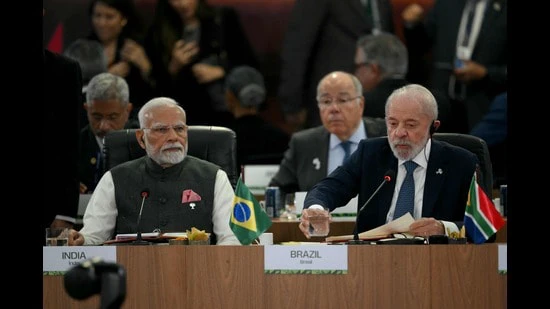Prime Minister (PM) Narendra Modi’s five-nation visit to Brazil, Argentina, Ghana, Trinidad & Tobago, and Namibia was dubbed as New Delhi’s outreach to the Global South, headlined by the Brics Summit in Rio de Janeiro.
As far as visits go, this was a routine exercise in diplomacy and New Delhi’s way of courting the developing world. The Rio summit will be remembered mostly for the absence of the Chinese and Russian presidents, and the inclusion of Indonesia to the grouping. Whether an expanded Brics will eventually present an alternative to the western-led order is open for debate.
But politics is secondary to business when it comes to Latin America. PM Modi’s visit complements an existing economic relationship that is driven largely by private actors across India and the Latin America and Caribbean (LAC) region. There is far more interplay between Sao Paulo and Mumbai than there is between Brasilia and New Delhi.
From a trade standpoint, India is more important to Brazil than the other way around. In 2024, India was Brazil’s ninth-largest trading partner; for India, Brazil was in the 27th place. Trade can also be viewed from a broader, global context. For example, India’s trade with far-off Brazil is about the same as trade with neighbouring Bangladesh, and India exports more to Brazil than it does to Japan or Turkey. Brazil’s trade with India is more than its trade with neighbouring Chile or with major economies like South Korea or France.
When we look at specific sectors, the significance of India-Latin America trade amplifies multifold. Over the past decade, 42% of Argentina’s vegetable oil exports have been shipped to India; that number reached 52% in 2024. On the other hand, India is amongst the largest providers of Latin America’s pharmaceutical products, agrochemicals, two- and three-wheelers, amongst other products. In large part, India exports value-added products to Latin America, while the region exports mostly commodities to India. The exceptions are India’s exports of unwrought aluminium or cotton, and Latin America’s exports of wine and processed foods.
More edifying is the investment between India and the LAC region. Indian companies employ about 16,000 people in Brazil, and 8,000 in Argentina. Across the region, the number reaches nearly 100,000. For some Indian companies, like the agrochemical giant UPL, Latin America remains the highest revenue generator, with nearly 40% of UPL’s global revenue coming from Latin America.
There are more strategic sectors in play: Brazil’s aviation giant Embraer recently opened a subsidiary in New Delhi, and India’s EXIM Bank opened its office in Sao Paulo earlier this year, its first in the region. Previously, EXIM Bank’s office in Washington DC managed its Latin America portfolio. In June 2025, the Indian Farmers Fertiliser Cooperative (IFFCO) announced that Brazil will be the destination for its first overseas nano fertiliser manufacturing plant. In Argentina, India’s State-owned Kabil has started exploration of lithium blocks in 2024. Once India establishes a lithium value chain domestically, including refineries capable of processing industrial salts, lithium carbonate and lithium hydroxide, its investments in Latin America’s lithium triangle could be a valuable contribution to securing direct and stable access to the critical mineral.
Modi’s overtures to countries like Brazil and Argentina, and the previous visits by India’s foreign minister S Jaishankar to eight LAC countries, are proof of an increase in political will. Yet, this should not be framed only within the context of India’s outreach to the Global South, which dilutes the region’s importance. Instead, New Delhi should formulate a standalone Latin America strategy, built on a foundation of energy and food security, and critical minerals.
There is a natural complementarity between India and the LAC region: What India needs, Latin America has in abundance, such as mineral resources, large arable land for agriculture, and copious reserves of petroleum. Latin America, on the other hand, regularly seeks out India for its affordable health care and pharmaceutical products, its vehicles and machinery, amongst other things. The three pillars that New Delhi’s strategy can be founded on – energy security, food security and critical minerals – are bound to become even more pertinent in the future, and India should not lose out by being a slow mover.
Hari Seshasayee is co-founder of Consilium Group and visiting fellow at the Observer Research Foundation (ORF). The views expressed are personal.
